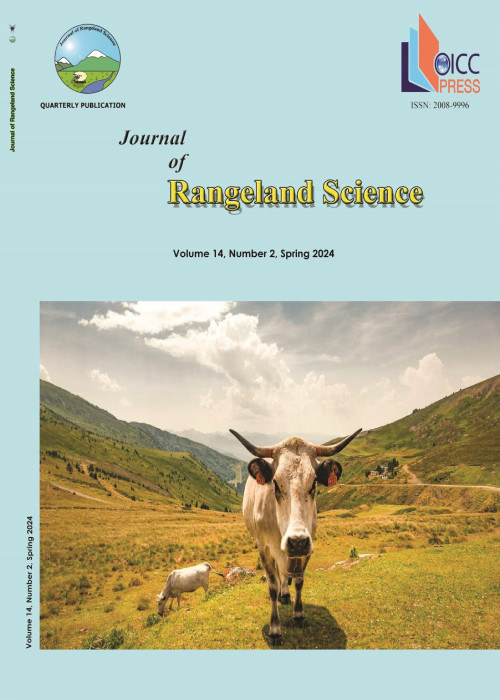Influence of Climatic Factors on Forage Production and Vegetation Cover of Iran's Upland Rangeland (Jashloobar Rangeland, Semnan Province)
Author(s):
Article Type:
Research/Original Article (دارای رتبه معتبر)
Abstract:
Annual climate fluctuations cause changes in production, condition, trends and grazing capacity of rangelands. The present study investigated effect of climatic factors on the vegetation dynamics in Jashloobar, summer rangeland of Semnan province, Iran, in two vegetation types: Festuca rubra in Margesar and Stipa lessingiana in Sefiddasht during 2011–2015. Climatic parameters included temperature (mean daily, absolute maximum, absolute minimum, monthly maximum and monthly minimum), monthly humidity (absolute maximum, absolute minimum and average) and monthly precipitation. These factors were determined by Inverse Distance Weighted method using 19 meteorological stations in Semnan province due to an absence of climatological and synoptic stations on this site. Vegetation cover percent and production were measured within two 400m transects and 20 plots (1×1m2) along transects. Means comparisons were made between the years in terms of vegetation production and canopy cover using Duncan test, and the relationship between climatic factors with vegetation parameters which were determined using linear regression. Results show that production varies significantly over years (P<0.05). The lowest production rates in Margesar and Sefiddasht were observed in 2013-2014 with 254 and 213.3 kg/ha respectively. Although the precipitation significantly decreased from 293 mm in 2011-2012 to 173 mm in 2013-2014(P<0.05), but stepwise regression indicated that finally in Margesar, absolute maximum temperature and absolute minimum humidity in December and in Sefiddasht, absolute maximum temperature in June and absolute minimum temperature in August were entered in production forecasting model. This indicates that forage production is highly sensitive to absolute mentioned climatic parameters in addition to rainfall. Also, due to short period of growing season in these years, grazing period should also be limited; therefore, ranchers and the government should optimize rangeland management and reduce the length of the grazing period, decreasing grazing capacity or alternative livelihoods such as ecotourism, beekeeping and exploitation of medicinal plants.
Keywords:
Language:
English
Published:
Journal of Rangeland Science, Volume:11 Issue: 4, Autumn 2021
Pages:
386 to 401
magiran.com/p2329094
دانلود و مطالعه متن این مقاله با یکی از روشهای زیر امکان پذیر است:
اشتراک شخصی
با عضویت و پرداخت آنلاین حق اشتراک یکساله به مبلغ 1,390,000ريال میتوانید 70 عنوان مطلب دانلود کنید!
اشتراک سازمانی
به کتابخانه دانشگاه یا محل کار خود پیشنهاد کنید تا اشتراک سازمانی این پایگاه را برای دسترسی نامحدود همه کاربران به متن مطالب تهیه نمایند!
توجه!
- حق عضویت دریافتی صرف حمایت از نشریات عضو و نگهداری، تکمیل و توسعه مگیران میشود.
- پرداخت حق اشتراک و دانلود مقالات اجازه بازنشر آن در سایر رسانههای چاپی و دیجیتال را به کاربر نمیدهد.
In order to view content subscription is required
Personal subscription
Subscribe magiran.com for 70 € euros via PayPal and download 70 articles during a year.
Organization subscription
Please contact us to subscribe your university or library for unlimited access!



